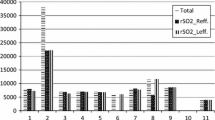Abstract
Near-infrared spectroscopy (NIRS) can monitor changes in cerebral regional oxygen saturation (rSO2) and tissue hemoglobin content (HbT). The relation between cerebral NIRS readings and vital parameters has not been analyzed before at a fine temporal scale. This study analyzed this relation during cardiopulmonary bypass (CPB) surgery in 10 children (0–9 years, 1,770 min of data records) by using a novel random-coefficient model. The analysis indicated that a small number of patients is sufficient for obtaining significant results with this model. Changes of vital parameters explained 84.7 % of rSO2 changes and 90.7 % of HbT changes. Cerebral rSO2 correlated positively with perfusion pressure and inversely with body temperature (P < 0.05). Cerebral HbT correlated positively with perfusion pressure, central venous pressure, and temperature and inversely with arterial oxygen saturation (P < 0.05). During hypothermic circulatory arrest, the half-life of the exponential rSO2 decay correlated to the rSO2 reserve (P = 0.016). In conclusion, NIRS readings of cerebral hemoglobin content and tissue oxygen saturation correlate well to vital parameters during CPB surgery in children. NIRS may therefore become a monitoring device for the neuroprotective optimization of those vital parameters.


Similar content being viewed by others
Abbreviations
- CPB:
-
Cardiopulmonary bypass
- HbT:
-
Cerebral tissue hemoglobin content
- NIRS:
-
Near infrared spectroscopy
- rSO2:
-
Cerebral regional oxygen saturation
References
Abdul-Khaliq H, Schubert S, Troitzsch D, Huebler M, Boettcher W, Baur MO et al (2001) Dynamic changes in cerebral oxygenation related to deep hypothermia and circulatory arrest evaluated by near-infrared spectroscopy. Acta Anaesthesiol Scand 45:696–701
Abdul-Khaliq H, Troitzsch D, Schubert S, Wehsack A, Bottcher W, Gutsch E et al (2002) Cerebral oxygen monitoring during neonatal cardiopulmonary bypass and deep hypothermic circulatory arrest. Thorac Cardiovasc Surg 50:77–81
Armitage P, Berry G (1994) Statistical methods in medical research, 3rd edn. Blackwell Science, Oxford
Ashwood ER, Kost G, Kenny M, Bacher A (1983) Temperature correction of blood-gas and pH measurements. Effects of body temperature on blood gases. Clin Chem 29:1877–1885
Chatfield C (1989) The analysis of time series: an introduction, 4th edn. Chapman & Hall, London
Daubeney PE, Smith DC, Pilkington SN, Lamb RK, Monro JL, Tsang VT et al (1998) Cerebral oxygenation during paediatric cardiac surgery: identification of vulnerable periods using near infrared spectroscopy. Eur J Cardiothorac Surg 13:370–377
Dobson AJ, Barnett AG (2008) An introduction to generalized linear models, 3rd edn. CRC Press, Boca Raton
Ginther R, Sebastian VA, Huang R, Leonard SR, Gorney R, Guleserian KJ et al (2011) Cerebral near-infrared spectroscopy during cardiopulmonary bypass predicts superior vena cava oxygen saturation. J Thorac Cardiovasc Surg 142:359–365
Hale GM, Querry MR (1973) Optical constants of water in the 200-nm to 200-microm wavelength region. Appl Opt 12:555–563
Hoffman GM, Stuth EA, Jaquiss RD, Vanderwal PL, Staudt SR, Troshynski TJ et al (2004) Changes in cerebral and somatic oxygenation during stage 1 palliation of hypoplastic left heart syndrome using continuous regional cerebral perfusion. J Thorac Cardiovasc Surg 127:223–233
Jöbsis FF (1977) Noninvasive infrared monitoring of cerebral and myocardial oxygen sufficiency and circulatory parameters. Science 198:1264–1267
Kurth CD, Steven JM, Nicolson SC (1995) Cerebral oxygenation during pediatric cardiac surgery using deep hypothermic circulatory arrest. Anesthesiology 82:74–82
Kussman BD, Wypij D, DiNardo JA, Newburger JW, Mayer JE Jr, del Nido PJ et al (2009) Cerebral oximetry during infant cardiac surgery: evaluation and relationship to early postoperative outcome. Anesth Analg 108:1122–1131
Kussman BD, Wypij D, Laussen PC, Soul JS, Bellinger DC, DiNardo JA et al (2010) Relationship of intraoperative cerebral oxygen saturation to neurodevelopmental outcome and brain magnetic resonance imaging at 1 year of age in infants undergoing biventricular repair. Circulation 122:245–254
Littell RC, Milliken GA, Stroup WW, Wolfinger RD, Schabenberger O (2006) SAS for mixed models, 2nd edn. SAS Institute, Cary
Menke J (2009) Diagnostic accuracy of contrast-enhanced MR angiography in severe carotid stenosis: meta-analysis with metaregression of different techniques. Eur Radiol 19:2204–2216
Menke J (2010) Bivariate random-effects meta-analysis of sensitivity and specificity with SAS PROC GLIMMIX. Methods Inf Med 49:54–64
Menke J, Voss U, Möller G, Jorch G (2003) Reproducibility of cerebral near infrared spectroscopy in neonates. Biol Neonate 83:6–11
Menke J, Stöcker H, Sibrowski W (2004) Cerebral oxygenation and hemodynamics during blood donation studied by near-infrared spectroscopy. Transfusion 44:414–421
Menke J, Larsen J, Kallenberg K (2011) Diagnosing cerebral aneurysms by computed tomographic angiography: meta-analysis. Ann Neurol 69:646–654
Morimoto Y, Niida Y, Hisano K, Hua Y, Kemmotsu O, Murashita T et al (2003) Changes in cerebral oxygenation in children undergoing surgical repair of ventricular septal defects. Anaesthesia 58:77–83
Moritz S, Rochon J, Volkel S, Hilker M, Hobbhahn J, Graf BM et al (2010) Determinants of cerebral oximetry in patients undergoing off-pump coronary artery bypass grafting: an observational study. Eur J Anaesthesiol 27:542–549
Ottens J, Tuble SC, Sanderson AJ, Knight JL, Baker RA (2010) Improving cardiopulmonary bypass: does continuous blood gas monitoring have a role to play? J Extra Corpor Technol 42:191–198
Tisdall MM, Taylor C, Tachtsidis I, Leung TS, Elwell CE, Smith M (2009) The effect on cerebral tissue oxygenation index of changes in the concentrations of inspired oxygen and end-tidal carbon dioxide in healthy adult volunteers. Anesth Analg 109:906–913
van Staveren HJ, Moes CJ, van Marie J, Prahl SA, van Gemert MJ (1991) Light scattering in Intralipid-10% in the wavelength range of 400–1100 nm. Anesth Analg 30:4507–4514
Watzman HM, Kurth CD, Montenegro LM, Rome J, Steven JM, Nicolson SC (2000) Arterial and venous contributions to near-infrared cerebral oximetry. Anesthesiology 93:947–953
Wolf M, Evans P, Bucher HU, Dietz V, Keel M, Strebel R, von Siebenthal K (1997) Measurement of absolute cerebral haemoglobin concentration in adults and neonates. Adv Exp Med Biol 428:219–227
Author information
Authors and Affiliations
Corresponding author
Electronic supplementary material
Below is the link to the electronic supplementary material.
Rights and permissions
About this article
Cite this article
Menke, J., Möller, G. Cerebral Near-Infrared Spectroscopy Correlates to Vital Parameters During Cardiopulmonary Bypass Surgery in Children. Pediatr Cardiol 35, 155–163 (2014). https://doi.org/10.1007/s00246-013-0754-9
Received:
Accepted:
Published:
Issue Date:
DOI: https://doi.org/10.1007/s00246-013-0754-9




